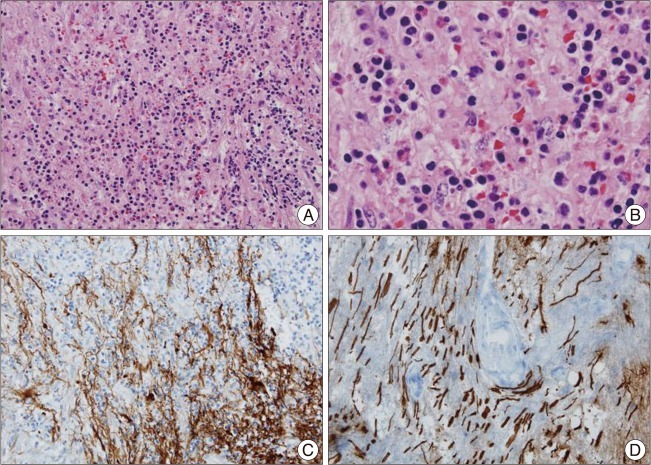J Korean Neurosurg Soc.
2012 Oct;52(4):410-413. 10.3340/jkns.2012.52.4.410.
Eosinophilic Myelitis in the Cervical Cord Mimicking Intramedullary Cord Tumor
- Affiliations
-
- 1Department of Neurosurgery, Konkuk University School of Medicine, Seoul, Korea. s1nsman@chol.com
- KMID: 2190662
- DOI: http://doi.org/10.3340/jkns.2012.52.4.410
Abstract
- Eosinophilic myelitis (EM) or atopic myelitis is a rare disease characterized by a myelitic condition in the spinal cord combined with allergic process. This disease has specific features of elevated serum IgE level, active reaction to mite specific antigen and stepwise progression of mostly the sensory symptoms. Toxocariasis can be related with a form of EM. This report describes two cases of cervical eosinophilic myelitis initially considered as intramedullary tumors. When a differential diagnosis of the intramedullary spinal cord lesion is in doubt, evaluation for eosinophilic myelitis and toxocariasis would be beneficial.
MeSH Terms
Figure
Reference
-
1. Goffette S, Jeanjean AP, Duprez TP, Bigaignon G, Sindic CJ. Eosinophilic pleocytosis and myelitis related to Toxocara canis infection. Eur J Neurol. 2000; 7:703–706. PMID: 11136359.
Article2. Gregoire SM, Mormont E, Laloux P, Godfraind C, Gilliard C. Atopic myelitis : a clinical, biological, radiological and histopathological diagnosis. J Neurol Sci. 2006; 247:231–235. PMID: 16782129.
Article3. Kikuchi H, Osoegawa M, Ochi H, Murai H, Horiuchi I, Takahashi H, et al. Spinal cord lesions of myelitis with hyperIgEemia and mite antigen specific IgE (atopic myelitis) manifest eosinophilic inflammation. J Neurol Sci. 2001; 183:73–78. PMID: 11166798.
Article4. Kim YR, Song JH, Park HK, Kim SH. A retrospective analysis of MRI-verified 29 cases of transverse myelitis. J Korean Neurosurg Soc. 2000; 29:1642–1649.5. Kira J, Kawano Y, Horiuchi I, Yamada T, Imayama S, Furue M, et al. Clinical, immunological and MRI features of myelitis with atopic dermatitis (atopic myelitis). J Neurol Sci. 1999; 162:56–61. PMID: 10064169.
Article6. Lee IH, Kim ST, Oh DK, Kim HJ, Kim KH, Jeon P, et al. MRI findings of spinal visceral larva migrans of Toxocara canis. Eur J Radiol. 2010; 75:236–240. PMID: 19447576.
Article7. Lee JY, Kim BJ, Lee SP, Jeung YJ, Oh MJ, Park MS, et al. Toxocariasis might be an important cause of atopic myelitis in Korea. J Korean Med Sci. 2009; 24:1024–1030. PMID: 19949655.
Article8. Na SJ, Lee KO, Ko JH. Eosinophilic vasculitis of the spinal cord associated with Churg-Strauss syndrome. J Neurol Sci. 2010; 295:107–109. PMID: 20538303.
Article9. Osoegawa M, Ochi H, Kikuchi H, Shirabe S, Nagashima T, Tsumoto T, et al. Eosinophilic myelitis associated with atopic diathesis : a combined neuroimaging and histopathological study. Acta Neuropathol. 2003; 105:289–295. PMID: 12557017.
Article10. Schmutzhard E. Eosinophilic myelitis, a souvenir from South East Asia. Pract Neurol. 2007; 7:48–51. PMID: 17430865.11. Shon HS, Kim SH, Lee SH, Lee SY, Kim SE, Yeo MJ. Eosinophilic myelitis associated with toxocariasis. J Korean Neurol Assoc. 2009; 27:176–178.
- Full Text Links
- Actions
-
Cited
- CITED
-
- Close
- Share
- Similar articles
-
- A Case of Intramedullary Myelitis due to Bacterial Meningitis with Cervical Epidural Abscess
- Intramedullary Metastatic Spinal Cord Tumor: A Case Report
- Eosinophilic Myelitis Associated With Toxocariasis
- A Case of Spinal Cord Cavernoma Mimicking Transverse Myelitis
- A Case of Intramedullary Tuberculous Abscess at Cervical Cord




